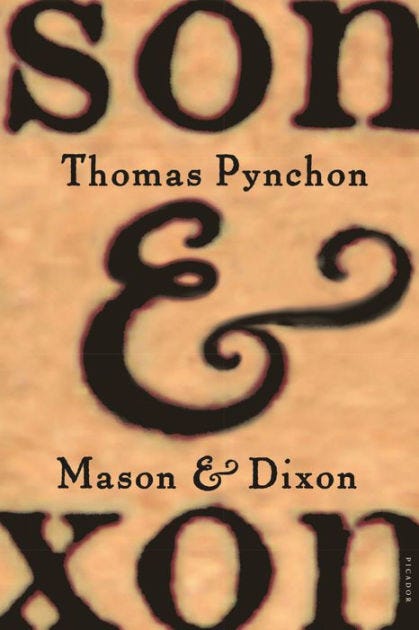Mason & Dixon - An Analysis
How did the events of the 18th-century set up a world which would usher in the reign of the capitalist Elite?
Hi all and welcome back,
Next up we will be moving through Thomas Pynchon’s fifth novel (sixth published work), Mason & Dixon (1997). We will be going back far in time, about 180 years before the events of Gravity’s Rainbow, to observe Charles Mason and Jeremiah Dixon traveling the world, eventually landing in America to be tasked with mapping certain borders of the colonies.
The plan for the foreseeable future of this SubStack will be to analyze each of Pynchon’s novels chronologically (in regard to historical dates, not publication dates): Mason & Dixon, Against the Day, V., The Crying of Lot 49, Inherent Vice, Vineland, and Bleeding Edge, in that order. We will be able to thus analyze how the world was set up to allow the events of Gravity’s Rainbow to occur so readily, and the events that branched out of Gravity’s Rainbow. (I believe I will also do his short stories from Slow Learner at some point).
I want to analyze Mason & Dixon in its own light, because that is what it deserves, but I also will be often going back to references in Gravity’s Rainbow in order to elicit parallels and show connections. Because of that, I do think you’ll get a bit more out of this if you’ve read Gravity’s Rainbow (and especially if you’ve followed along with my specific analysis of it), but it is far from necessary. This analysis will be 95+% strictly Mason & Dixon with, like I said, occasional references, parallels, and precursors to the events of Gravity’s Rainbow and the historical period in which Gravity’s Rainbow takes place.
The plan will remain as it was, being one post a week which will usually cover one chapter of the novel unless the chapter is exceedingly long. There will also be individual posts that cover the titles of each part and ideas of what to look out for within those specific parts (this novel has three Parts compared to Gravity’s Rainbow’s four, and one of those parts takes up about 60-70% of the novel). And along with that, audio posts will be available for all paid subscribers.
If you’re new: this analysis is not a traditional literary analysis moving through via literary criticism lenses, or an analysis of the work as a contribution to literature, or about how Pynchon deconstructed the traditional medium. It will be an analysis of what Pynchon is quite literally attempting to say about our contemporary world including the revelations he is making via interpretations regarding parapolitics, Marxist/Anarchist/Leftist/anti-Capitalist ideologies, various forms of governmental control, psychology, imperialism/colonialism, revolution, history (often the histories not taught in school), commodification, power structures, materialism, spiritualism, and other similar themes.
So next week, expect to see a general analysis of the title of the novel, Mason & Dixon, and of the title of Part 1, Latitudes and Departures. The week following will begin the novel proper.
See you all then!





Awesome!!
🙌